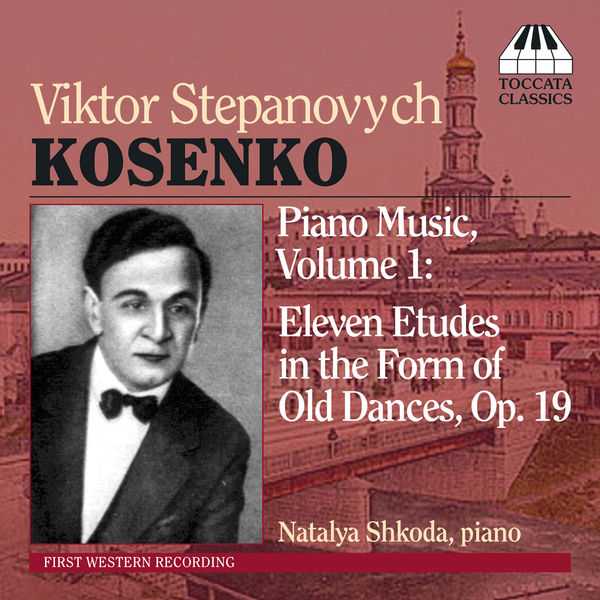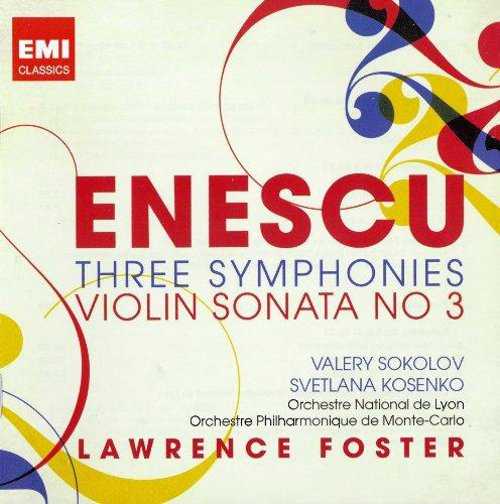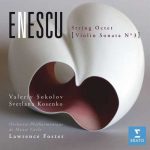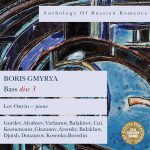
Composer: Viktor Kosenko
Performer: Natalya Shkoda
Format: FLAC (tracks)
Label: Toccata
Catalogue: TOCC0036
Release: 2006
Size: 211 MB
Recovery: +3%
Scan: cover
11 Etudes in the Form of Old Dances, Op. 19
01. No. 1, Gavotte in D-Flat Major
02. No. 2, Allemande in B-Flat Minor
03. No. 3, Menuet in G Major
04. No. 4, Courante in E Minor
05. No. 5, Sarabande in A Minor
06. No. 6, Bourree in A Major
07. No. 7, Gavotte in B Minor
08. No. 8, Rigaudon in C Major
09. No. 9, Menuet in E-Flat Major
10. No. 10, Passacaglia in G Minor
11. No. 11, Gigue in D Minor
Viktor Stepanovych Kosenko (1896-1938) was one of the most important Ukrainian composers and pianists of the first half of the twentieth century. His Eleven Etudes in the Form of Old Dances, Op. 19, of 1927-29 offer an organic synthesis of the late-Romantic piano tradition, neo-Classical impulses in their use of Baroque dance-forms, and elements of Ukrainian folk-music. This recording of a neglected monument in the piano literature is the first step in the discovery of a composer who was once a cultural icon in his native Ukraine but is now as good as unknown outside its borders.
These piano works by Ukrainian composer Viktor Kosenko (1896-1938) deliver exactly what is advertised in the title: they are concert etudes in the Romantic tradition, underlaid by and sort of growing out of the rhythms of the dances of the Baroque suite — the gavotte, allemande, minuet, courante, gigue, and so on. The Baroque titles lead one to expect a neo-Classical work touched by Stravinsky’s dry aesthetic, and certainly Kosenko must have been influenced somewhere along the way by the rediscovery of early music. But the pieces are oriented toward Romantic pianistic display. It’s almost as if Chopin had written a few gavottes and bourrées along with his mazurkas and waltzes. Yet the formality of the Baroque dances also shapes the music, as does a very subtle nationalist tinge expressed mostly in modal harmonies. The interest in Kosenko’s dances often resides in how he makes the transition from circumspect dance rhythms at the opening of a piece to full-scale pianism by its end, creating a small structure that fuses diverse elements in a completely new way. These pieces don’t really resemble any other music of the 1920s, and their rediscovery (or, really, transfer to the West) by Ukrainian-American pianist Natalya Shkoda is most welcome. Their closest relatives, oddly enough, may be the phony Baroque works Fritz Kreisler composed in order to add to his repertoire music that was essentially Romantic but had an appealingly mysterious whiff of the antique. The set contains a Passacaglia, track 10, which doesn’t quite fit with the rest of the group (it is nearly 19 minutes long, and despite the passacaglia’s dance origins it is not really a dance, contrary to what Shkoda’s rather doctoral booklet notes state). The Passacaglia does provide Shkoda with the opportunity to display her considerable power. This unique music raises interest in future releases in a Kosenko series planned by Shkoda, and it provides fresh illustration of how many gems were left in the ground, especially in Eastern Europe, as modernism took hold in the West. Student pianists looking for unusual works to add to their recitals (hint: the mood of any evaluator is instantly improved upon discovering good new music) are advised to check these dances out.



